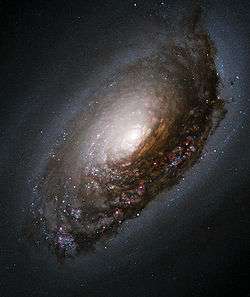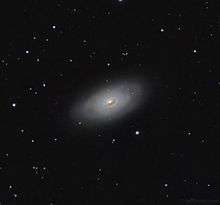Black Eye Galaxy
 | |
| The Black Eye Galaxy (M64) | |
| Observation data Epoch J2000 | |
|---|---|
| Constellation | Coma Berenices[2] |
| Right ascension | 12h 56m 43.7s[3] |
| Declination | +21° 40′ 58″[3] |
| Apparent dimension (V) | 10.71 × 5.128 moa[4] |
| Apparent magnitude (V) | 9.36[3] |
| Characteristics | |
| Type | (R)SA(rs)ab, HIISy2 |
| Astrometry | |
| Heliocentric radial velocity | 408 ± 4[3] km/s |
| Redshift | 0.001361 ± 0.000013[3] |
| Galactocentric velocity | 400 ± 4 km/s |
| Distance | 24 ± 7[5] Mly (7.36 ± 2.15 Mpc) |
| Other designations | |
| Database references | |
| SIMBAD | Search M64 data
|
| See also: Galaxy, List of galaxies | |
The Black Eye Galaxy (also called Evil Eye Galaxy; designated Messier 64, M64, or NGC 4826) is a galaxy which was discovered by Edward Pigott in March 1779, and independently by Johann Elert Bode in April of the same year, as well as by Charles Messier in 1780. It has a spectacular dark band of absorbing dust in front of the galaxy's bright nucleus, giving rise to its nicknames of the "Black Eye" or "Evil Eye" galaxy. M64 is well known among amateur astronomers because of its appearance in small telescopes. It is a spiral galaxy in the Coma Berenices constellation.
Properties
The interstellar medium of Messier 64 comprises two counter-rotating disks which are approximately equal in mass.[6] The inner disk contains the prominent dust lanes of the galaxy. The stellar population of the galaxy exhibits no measurable counter-rotation.[7] Possible formation scenarios include a merger with a gas-rich satellite galaxy in a retrograde orbit, or the continued accretion of gas clouds from the intergalactic medium.[6][7]

References
- ↑ J. L. Tonry; A. Dressler; J. P. Blakeslee; E. A. Ajhar; A. B. Fletcher; G. A. Luppino; et al. (2001). "The SBF Survey of Galaxy Distances. IV. SBF Magnitudes, Colors, and Distances". Astrophysical Journal. 546 (2): 681–693. Bibcode:2001ApJ...546..681T. arXiv:astro-ph/0011223
 . doi:10.1086/318301.
. doi:10.1086/318301. - ↑ R. W. Sinnott, ed. (1988). The Complete New General Catalogue and Index Catalogue of Nebulae and Star Clusters by J. L. E. Dreyer. Sky Publishing Corporation/Cambridge University Press. ISBN 0-933346-51-4.
- 1 2 3 4 5 6 7 8 9 "NASA/IPAC Extragalactic Database". Results for NGC 4826. Retrieved 2006-11-06.
- 1 2 "Object query : M64". SIMBAD. Centre de Données astronomiques de Strasbourg. Retrieved 2008-07-09.
- ↑ This number has been estimated from 17Mly to even higher numbers than 24Mly. I feel it would be safe to say a distance error of 7 Mly would be sufficient to cover most estimates.
- 1 2 R. Brawn; R. A. M. Walterbos & Kennicutt R. C. (1992). "Counter-rotating gaseous disks in the "Evil Eye" galaxy NGC4826". Nature. 360: 442. Bibcode:1992Natur.360..442B. doi:10.1038/360442a0.
- 1 2 H.-W. R. Rix; R. C. Kennicutt & R. A. M. Walterbos (1995). "Placid stars and excited gas in NGC 4826". Astrophysical Journal. 438: 155. Bibcode:1995ApJ...438..155R. doi:10.1086/175061.
External links
| Wikimedia Commons has media related to Black Eye Galaxy. |
- Messier 64, SEDS Messier pages
- Hubblesite description and high resolution images
- ESA/Hubble images of M64
- NASA Astronomy Picture of the Day: M64: The Black Eye Galaxy (2 August 2007)
- The Black Eye Galaxy on WikiSky: DSS2, SDSS, GALEX, IRAS, Hydrogen α, X-Ray, Astrophoto, Sky Map, Articles and images
- a real photo by Pete Albrecht
- Black Eye Galaxy (M64) at Constellation Guide
Coordinates: ![]() 12h 56m 43.7s, +21° 40′ 58″
12h 56m 43.7s, +21° 40′ 58″
